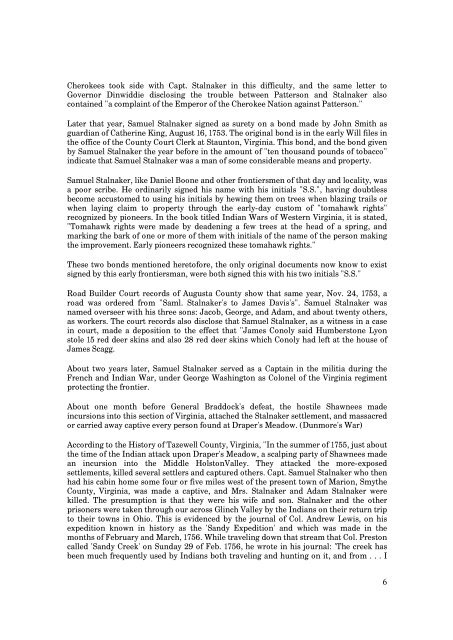Captain Samuel Stalnaker Colonial Soldier and Early Pioneer
Captain Samuel Stalnaker Colonial Soldier and Early Pioneer
Captain Samuel Stalnaker Colonial Soldier and Early Pioneer
Create successful ePaper yourself
Turn your PDF publications into a flip-book with our unique Google optimized e-Paper software.
Cherokees took side with Capt. <strong>Stalnaker</strong> in this difficulty, <strong>and</strong> the same letter to<br />
Governor Dinwiddie disclosing the trouble between Patterson <strong>and</strong> <strong>Stalnaker</strong> also<br />
contained "a complaint of the Emperor of the Cherokee Nation against Patterson."<br />
Later that year, <strong>Samuel</strong> <strong>Stalnaker</strong> signed as surety on a bond made by John Smith as<br />
guardian of Catherine King, August 16, 1753. The original bond is in the early Will files in<br />
the office of the County Court Clerk at Staunton, Virginia. This bond, <strong>and</strong> the bond given<br />
by <strong>Samuel</strong> <strong>Stalnaker</strong> the year before in the amount of "ten thous<strong>and</strong> pounds of tobacco"<br />
indicate that <strong>Samuel</strong> <strong>Stalnaker</strong> was a man of some considerable means <strong>and</strong> property.<br />
<strong>Samuel</strong> <strong>Stalnaker</strong>, like Daniel Boone <strong>and</strong> other frontiersmen of that day <strong>and</strong> locality, was<br />
a poor scribe. He ordinarily signed his name with his initials "S.S.", having doubtless<br />
become accustomed to using his initials by hewing them on trees when blazing trails or<br />
when laying claim to property through the early-day custom of "tomahawk rights"<br />
recognized by pioneers. In the book titled Indian Wars of Western Virginia, it is stated,<br />
"Tomahawk rights were made by deadening a few trees at the head of a spring, <strong>and</strong><br />
marking the bark of one or more of them with initials of the name of the person making<br />
the improvement. <strong>Early</strong> pioneers recognized these tomahawk rights."<br />
These two bonds mentioned heretofore, the only original documents now know to exist<br />
signed by this early frontiersman, were both signed this with his two initials "S.S."<br />
Road Builder Court records of Augusta County show that same year, Nov. 24, 1753, a<br />
road was ordered from "Saml. <strong>Stalnaker</strong>'s to James Davis's". <strong>Samuel</strong> <strong>Stalnaker</strong> was<br />
named overseer with his three sons: Jacob, George, <strong>and</strong> Adam, <strong>and</strong> about twenty others,<br />
as workers. The court records also disclose that <strong>Samuel</strong> <strong>Stalnaker</strong>, as a witness in a case<br />
in court, made a deposition to the effect that "James Conoly said Humberstone Lyon<br />
stole 15 red deer skins <strong>and</strong> also 28 red deer skins which Conoly had left at the house of<br />
James Scagg.<br />
About two years later, <strong>Samuel</strong> <strong>Stalnaker</strong> served as a <strong>Captain</strong> in the militia during the<br />
French <strong>and</strong> Indian War, under George Washington as Colonel of the Virginia regiment<br />
protecting the frontier.<br />
About one month before General Braddock's defeat, the hostile Shawnees made<br />
incursions into this section of Virginia, attached the <strong>Stalnaker</strong> settlement, <strong>and</strong> massacred<br />
or carried away captive every person found at Draper's Meadow. (Dunmore's War)<br />
According to the History of Tazewell County, Virginia, "In the summer of 1755, just about<br />
the time of the Indian attack upon Draper's Meadow, a scalping party of Shawnees made<br />
an incursion into the Middle HolstonValley. They attacked the more-exposed<br />
settlements, killed several settlers <strong>and</strong> captured others. Capt. <strong>Samuel</strong> <strong>Stalnaker</strong> who then<br />
had his cabin home some four or five miles west of the present town of Marion, Smythe<br />
County, Virginia, was made a captive, <strong>and</strong> Mrs. <strong>Stalnaker</strong> <strong>and</strong> Adam <strong>Stalnaker</strong> were<br />
killed. The presumption is that they were his wife <strong>and</strong> son. <strong>Stalnaker</strong> <strong>and</strong> the other<br />
prisoners were taken through our across Glinch Valley by the Indians on their return trip<br />
to their towns in Ohio. This is evidenced by the journal of Col. Andrew Lewis, on his<br />
expedition known in history as the 'S<strong>and</strong>y Expedition' <strong>and</strong> which was made in the<br />
months of February <strong>and</strong> March, 1756. While traveling down that stream that Col. Preston<br />
called 'S<strong>and</strong>y Creek' on Sunday 29 of Feb. 1756, he wrote in his journal: 'The creek has<br />
been much frequently used by Indians both traveling <strong>and</strong> hunting on it, <strong>and</strong> from . . . I<br />
6


